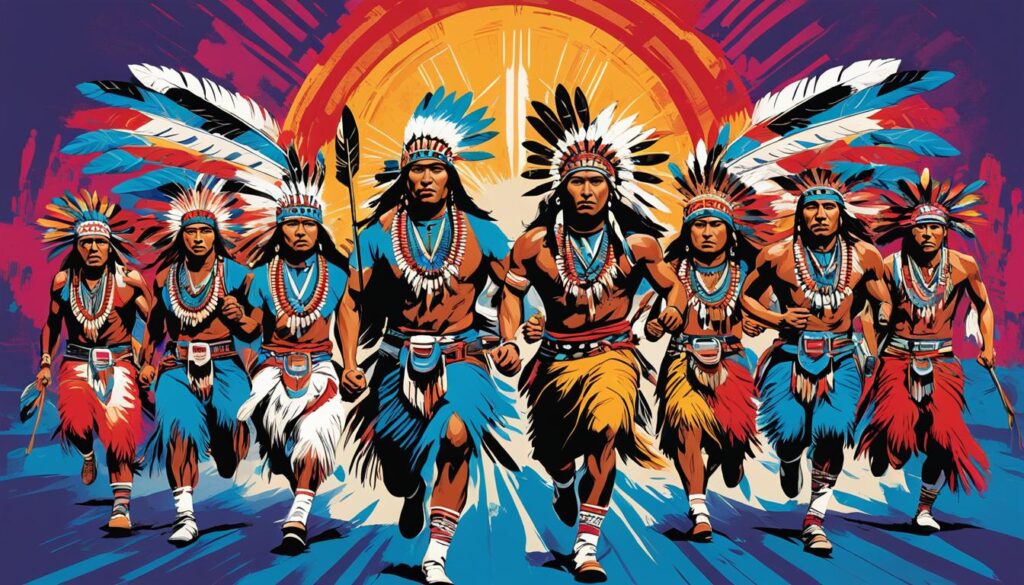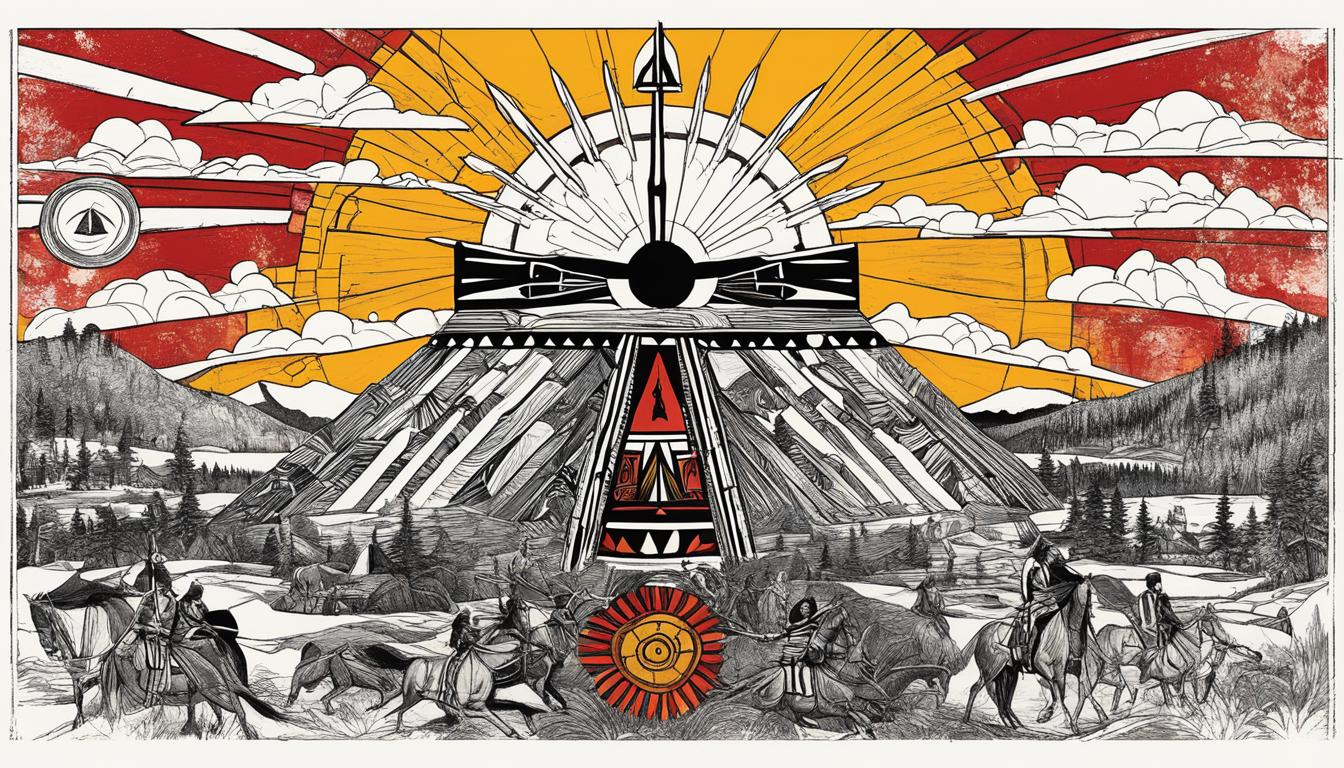If you’re looking for an audiobook that will take you on a journey through Native American history, “The Heartbeat of Wounded Knee” by David Treuer will not disappoint. This audiobook offers a profound exploration of Native American history from 1890 to the present, shedding light on the struggles, resilience, and triumphs of Native American communities.
David Treuer’s meticulous research and engaging storytelling make this audiobook a must-have for anyone interested in deepening their understanding of Native American history and culture. “The Heartbeat of Wounded Knee” provides a profound and candid perspective on the challenges faced by Native people and how they’ve persevered through the centuries.
Key Takeaways
- “The Heartbeat of Wounded Knee” audiobook offers a comprehensive exploration of Native American history from 1890 to the present.
- David Treuer’s storytelling techniques and the narration contribute to the overall listening experience.
- This audiobook sheds light on the struggles, resilience, and triumphs of Native American communities.
- “The Heartbeat of Wounded Knee” is a must-have for anyone interested in deepening their understanding of Native American history and culture.
- The audiobook provides a profound and candid perspective on the challenges faced by Native people and how they’ve persevered through the centuries.
Overview of “The Heartbeat of Wounded Knee”
“The Heartbeat of Wounded Knee” is an audiobook by Native American author David Treuer that offers a profound exploration of Native American history from 1890 to the present. Treuer, who himself is a member of the Ojibwe tribe, brings a unique perspective to the book, combining personal experience with extensive research. The audiobook is a masterful blend of history, memoir, and cultural critique, offering listeners a comprehensive understanding of Native America’s past and present.
The central theme of “The Heartbeat of Wounded Knee” centers around the resilience and strength of Native American communities, despite centuries of marginalization and oppression. The audiobook challenges stereotypical depictions of Native Americans and presents a refreshingly honest and nuanced view of their experiences. Through powerful storytelling and insightful analysis, Treuer uncovers the deep roots of Native American culture and exposes the continuing struggle for political and cultural sovereignty.
The audiobook also sheds light on lesser-known aspects of Native American history, such as the urban indigenous experience and the role of women in indigenous societies. It explores how Native Americans navigated the challenges of modernity and maintained a strong connection to their cultural heritage.
David Treuer: Author of “The Heartbeat of Wounded Knee”
David Treuer is an acclaimed Ojibwe author and historian, known for his works on Native American history and culture. He is the recipient of numerous awards, including the Pushcart Prize and the Minnesota Book Award. Treuer’s unique perspective on Native American history has challenged prevailing narratives and stimulated public discourse. In “The Heartbeat of Wounded Knee,” his nuanced and empathetic approach to storytelling elevates the book to a powerful and essential work on Native American history.
Historical Context: Native America in the Late 19th Century
The late 19th century was a tumultuous time for Native American communities. The history of Native America was characterized by a long and painful struggle against colonialism and land dispossession. As more settlers arrived in the United States, Native Americans were forced to adapt to new circumstances that fundamentally shifted their way of life.
The government’s policy of reservation systems instituted a rigid form of control over Native Americans. Despite this, some communities fiercely resisted, sparking conflicts such as the Wounded Knee Massacre. The late 19th century marked a turning point in Native American history, ultimately leading to significant changes in the community’s culture, language, and identity.
Impact of Colonialism
Native America’s encounter with colonialism had a profound effect on the community. European settlers introduced new forms of governance, trade, and religion, which fundamentally transformed Native American life. The Indian Appropriation Act of 1871 marked a significant shift in US government policy as it ended the system where Native American lands were treated as sovereign nations and established the reservation system. The Indian Boarding School policy was implemented, forcing Native children to attend boarding schools with the aim of uprooting their native culture and language.
Challenges Faced by Native Communities
The reservation system and forced removal of Native individuals from their homes brought about significant challenges, from poverty to health issues. Living on poor land with little resources, their way of life was increasingly difficult to sustain, leading to illness and malnutrition. Along with this, the outlaw of cultural and religious practices led to the loss of sacred cultural practices and identity, leading to a breakdown in community structures.
The Wounded Knee Massacre and Its Aftermath
On December 29, 1890, soldiers of the United States Army opened fire on a group of unarmed Lakota Sioux at Wounded Knee Creek in South Dakota. More than 250 men, women, and children were killed in the massacre, which effectively ended the era of Native American resistance to the government’s expansionist policies.
The Wounded Knee Massacre was not an isolated incident but rather a culmination of years of tension and violence between Native communities and the federal government. In the wake of the massacre, many Native American leaders were arrested and imprisoned, further quelling any resistance movements.
Despite the widespread devastation caused by the Wounded Knee Massacre, Native American communities were not defeated. In the aftermath of the tragedy, new resistance movements emerged, emphasizing the importance of cultural preservation and political activism.
The impact of the Wounded Knee Massacre on Native American history cannot be overstated. The massacre was a turning point in the struggle between Native communities and the government, and it continues to be a powerful symbol of Native resistance and resilience.
Key Figures of the Wounded Knee Massacre
| Name | Role |
|---|---|
| Big Foot | Lakota Sioux leader who was leading the group that was massacred |
| James W. Forsyth | Commander of the Seventh Cavalry Regiment that carried out the massacre |
| Red Cloud | Lakota Sioux leader who was a vocal critic of the government’s treatment of Native Americans |
Reconstruction and Assimilation Policies
During the late 19th and early 20th centuries, reconstruction policies were implemented by the US government to address the aftermath of the Civil War. Unfortunately, these policies also heavily impacted Native American culture by forcing assimilation efforts onto Native communities.
Under the policy of assimilation, Native Americans were forced to abandon their traditions and adopt white American culture. Children were taken from their families and sent to boarding schools, often far away from their tribes, where they were forbidden to speak their own language or practice their own religion. The overall goal of these policies was to erase Native culture and assimilate Native Americans into the dominant American society.
These reconstruction and assimilation policies had devastating effects on Native American communities, leading to the loss of cultural identity and widespread trauma. Traditional ways of life were disrupted, and families were torn apart. Disease, poverty, and violence were rampant, further exacerbating the damage done by the policies.
Impact of Assimilation on Native American Culture
One of the most significant impacts of assimilation policies was the loss of Native American culture and traditions. Prior to the arrival of Europeans, Native American cultures were diverse and thriving. But the assimilation policies enacted by the US government aimed to force Native Americans to abandon their own ways of life and adopt those of white Americans. As a result, many traditions were lost and forgotten, and this cultural genocide had a lasting impact on Native communities.
In addition to the loss of culture, assimilation policies also resulted in widespread trauma and damage to Native American communities. The forced removal of children from their families led to a breakdown of traditional family structures and social frameworks. This, in turn, disrupted economic systems and led to poverty and unemployment within Native communities.
The Fight for Native American Rights
Despite the attempts to assimilate Native Americans, many individuals and communities fought back against these policies and advocated for their rights. Resistance movements emerged throughout the late 19th and early 20th centuries, as Native Americans sought to reclaim their cultural identity and assert their sovereignty as distinct nations.
In the 1970s, the American Indian Movement (AIM) brought national attention to Native American issues, including land rights, cultural preservation, and political representation. These efforts paved the way for significant legislative changes, including the Indian Self-Determination and Education Assistance Act of 1975, which granted Native communities greater control over their own affairs.
Despite these strides, many challenges still face Native American communities today, including issues of poverty, discrimination, and environmental concerns. However, through their resilience and persistence, Native Americans continue to fight for their rights and preserve their cultural identity.
Native American Resurgence in the 20th Century
Section 6 explores the Native American resurgence movement that began in the 1960s and continues to this day. This movement marked a significant shift in Native American communities’ attitudes towards their cultural identity and traditions. Activists started protesting against the government’s treatment of indigenous people, demanding legal recognition of their tribal sovereignty and their right to self-determination.
The resurgence movement aimed to promote and preserve Native American culture, traditions, and languages. It helped to raise awareness of the issues that have been plaguing Native communities for centuries, such as poverty, discrimination, and the loss of cultural heritage.
The movement also led to the establishment of various organizations dedicated to advancing Native American interests, such as the National Congress of American Indians and the American Indian Movement. These organizations helped empower Native American communities and advocated for policy changes at the local, state, and federal levels.
One of the most significant outcomes of the resurgence movement was the revitalization of Native American languages, many of which were on the verge of extinction. Activists started organizing language preservation programs, which have been successful in reviving and promoting indigenous languages. Today, Native American voices are being heard louder than ever, and they are increasingly being recognized for their unique contributions to American society.

The Significance of Cultural Identity
Cultural identity is an essential aspect of the Native American resurgence movement. It represents the recognition of indigenous people’s unique heritage and traditions and is an integral part of their struggle for self-determination and sovereignty. Through the promotion and preservation of cultural identity, Native American communities can maintain their traditions and pass them down to future generations.
Key Figures in the Native American Resurgence Movement
| Name | Role |
|---|---|
| Vine Deloria Jr. | Writer and activist |
| Wilma Mankiller | First female chief of the Cherokee Nation |
| Clyde Warrior | American Indian Movement activist |
| Winona LaDuke | Environmental activist and politician |
| Suzan Shown Harjo | Policy advocate and founder of the Morning Star Institute |
This table highlights some of the key figures who played a pivotal role in the Native American resurgence movement. These individuals helped raise awareness of the issues facing Native American communities and contributed significantly to the advancement of Native American rights and interests.
Contemporary Challenges and Triumphs
Despite the progress made by Native Americans in recent years, ongoing challenges persist. Poverty rates among Native American communities remain high, with many families struggling to meet basic needs. Discrimination also continues to be a pervasive issue, with Native Americans facing prejudices and stereotypes in many aspects of life.
However, despite these challenges, Native Americans have also achieved significant triumphs in various fields. From art and literature to politics and business, Native individuals have made tremendous contributions to American society. For example, Joy Harjo, a Muscogee poet and musician, was named the first Native American Poet Laureate of the United States in 2019.
The table below showcases some notable achievements by Native Americans in recent years:
Notable Achievements by Native Americans
| Name | Field | Achievement |
|---|---|---|
| Teddy Draper Jr. | Art | Selected for the National Museum of the American Indian’s Artist Leadership Program (2019) |
| Sharice Davids | Politics | Elected to the U.S. House of Representatives (2018) |
| Jewell Parker Rhodes | Literature | Won the American Library Association’s Coretta Scott King Book Award (2020) |
| Dr. Nicole Redvers | Healthcare | Named to the inaugural cohort of the Fulbright Arctic Initiative’s Health Equity working group (2020) |
These achievements highlight the resilience, creativity, and determination of Native Americans in overcoming obstacles and making meaningful contributions to society.
Narrative Style and Audiobook Performance
David Treuer’s “The Heartbeat of Wounded Knee” is a masterful exploration of Native American history, brought to life by his rich narrative style and powerful storytelling techniques. Treuer’s ability to infuse personal anecdotes with historical context creates a listening experience that is both engaging and informative.
The audiobook performance of “The Heartbeat of Wounded Knee” is a true gem, with voice actor Tanis Parenteau delivering a stellar performance. Her clear enunciation and emotive delivery add depth to Treuer’s words, capturing the essence of his storytelling. Together, Treuer’s narrative style and Parenteau’s audiobook performance offer a powerful and immersive listening experience that is not to be missed.
Impact and Relevance of “The Heartbeat of Wounded Knee”
David Treuer’s “The Heartbeat of Wounded Knee” offers a significant contribution to our understanding of Native American history, making it a must-read for anyone interested in the topic. The book’s impact stems from its thought-provoking insights into the struggles, resilience, and triumphs of Native American communities from 1890 to the present.
Moreover, “The Heartbeat of Wounded Knee” holds relevance in ongoing discussions about representation, historical accuracy, and cultural appreciation. By shedding light on the complexities and richness of Native American cultures, the book challenges stereotypes and encourages a deeper appreciation of Native American history.
Overall, “The Heartbeat of Wounded Knee” serves as a call to action for all of us to engage with Native American history, culture, and communities. It is a powerful reminder of the enduring impact of colonialism and the importance of listening to the voices of those who have been marginalized throughout history.
Critical Reception and Audience Response
“The Heartbeat of Wounded Knee” has garnered critical acclaim for its insightful exploration of Native American history. The book’s audiobook version has received positive and thoughtful reviews from both critics and audiences.
One of the most acclaimed reviews comes from Publishers Weekly, which states that “Treuer bounds across Indian Country to introduce visionary leaders who inspired resistance movements in the face of devastating losses and forced assimilation…Treuer’s chronicle is a powerful corrective to the idea of inevitable Native American defeat.”
The audiobook has also been praised for its effective narration by author David Treuer. The New York Times notes that “Treuer’s distinctive voice, in his narration and his insights, ensures that the listener remains glued to the story. Treuer tells the story of the Lakota Sioux and their struggle for survival with a steady and somber voice that captures the nuances of history.”
In the Native American literary community, “The Heartbeat of Wounded Knee” has been celebrated for its contribution to the representation and understanding of Native American history and culture. Author and educator Debbie Reese describes the book as “a comprehensive and deeply moving testament to the resilience, the strength, and the beauty of Indigenous peoples.”
Reviews and Ratings of “The Heartbeat of Wounded Knee” Audiobook
| Publication | Rating | Review Excerpt |
|---|---|---|
| Publishers Weekly | Starred Review | “Treuer bounds across Indian Country to introduce visionary leaders…Treuer’s chronicle is a powerful corrective to the idea of inevitable Native American defeat.” |
| The New York Times | Positive | “Treuer’s distinctive voice…captures the nuances of history.” |
| Booklist | Starred Review | “Fascinating, informative, and beautifully written.” |
| Kirkus Reviews | Positive | “An engrossing, well-researched history that will resonate with both scholars and general readers.” |
The critical reception and audience response to “The Heartbeat of Wounded Knee” audiobook reaffirms the book’s significance in Native American literature and its contribution to the ongoing dialogue about representation and understanding of Native American history. Its examination of the struggle, resilience, and cultural identity of Native Americans remains a vital and relevant topic today.
Conclusion
The Heartbeat of Wounded Knee audiobook provides a significant contribution to understanding the history and culture of Native America. David Treuer’s storytelling techniques and the narration truly bring to life the struggles, resilience, and triumphs of Native communities. This audiobook is a must-listen for anyone interested in deepening their historical knowledge and cultural appreciation of Native America.
The profound exploration of Native American history from 1890 to the present offers a comprehensive understanding of the challenges faced by Native communities and the impact of colonialism. By highlighting the Wounded Knee Massacre and subsequent resistance efforts, Treuer sheds light on the complexities of Native American identity and resilience.
Moreover, the book’s examination of reconstruction and assimilation policies provides a critical lens to better understand the efforts made to erase Native culture and its detrimental effects on Native communities. The resurgence movement in the 20th century is also highlighted to showcase the valuable efforts by Native Americans to reclaim their cultural identity and advocate for their rights.
Overall, the Heartbeat of Wounded Knee audiobook is an important addition to the Native American literature. It is highly recommended for anyone interested in understanding the complex and fascinating history of Native America.



